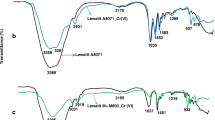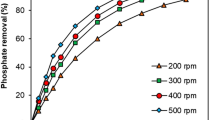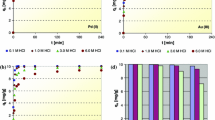Abstract
The performance of the Purolite A847 weak basic anion exchanger in the simultaneous removal of the azo dye Lanasyn Navy M-DNL (LNCr) and the phthalocyanine dye Acid Blue 249 (CuPc) from acidic aqueous solutions was studied under dynamic conditions. The comparison of FTIR spectra of unloaded and dye-loaded anion exchangers made it possible to consider suitable sorption mechanisms. The results of dynamic experiments revealed that anion exchanger had a greater dynamic sorption capacity with a longer breakthrough time and a shorter length of mass transfer zone when both dyes LNCr and CuPc were removed from the one-component solution as compared to those of their mixture. Models of Wolborska and Juang were found to be suitable to predict the character of breakthrough curves and to determine the characteristic parameters of the Purolite A847 column useful for process design: the mass transfer coefficient β (1/min) and time at the break point τ (minutes). The result would be useful in the design of wastewater treatment plants for removal of azo and phthalocyanine dyes from aqueous solutions and water recycling.






Similar content being viewed by others
References
Aksu, Z., & Catgatay, S. S. (2006). Investigation of biosorption of Gemazol Turquise Blue-G reactive dye by dried Rhizopus arrhizus in batch and continuous system. Separation and Purification Technology, 48, 24–35.
Allegre, C., Moulin, P., Maisseu, M., & Charbit, G. L. (2006). Treatment and reuse of reactive dyeing effluents. Journal of Membrane Science, 269, 15–34.
Beck, U., Stohr, F-M., Nickel, H. (1985). Phthalocyanine and azo dyestuff mixtures and their use for dyeing paper. Resource document. http://www.archpatent.com/patents/4521217. Accessed 25 Jun 2010
Bohart, G. S., & Adams, E. Q. (1920). Some aspects of the behaviour of charcoal with respect to chlorine. Journal of the American Chemical Society, 42, 523–529.
Borba, C. E., da Silva, E. A., Fagundes Klen, M. R., Kroumov, A. D., & Guirardello, R. (2008). Prediction of copper(II) ions dynamic removal from a medium by using mathematical models with analytical solution. Journal of Hazardous Materials, 152, 366–372.
Chiou, M. S., & Li, H. Y. (2003). Adsorption behavior of reactive dye in aqueous solution on chemical cross-linked chitosan beads. Chemosphere, 50, 1095–1105.
Chu, K. H. (2010). Fixed bed sorption: Setting the record straight on the Bohart-Adams and Thomas models. Journal of Hazardous Materials, 177, 1006–1012.
Clark, R. M. (1987). Evaluating the cost and performance of field-scale granular activated carbon systems. Environmental Science and Technology, 21, 573–580.
Coulson, J. M., Richardson, J. F., Backhurst, J. R., & Harker, J. H. (1991). Chemical engineering. Particle technology and separation processes (4th ed., Vol. 2). Bath: Butterworth-Heineman.
Dorfner, K. (Ed.). (1991). Ion exchangers. Berlin: Walter de Gruyter.
Dragan, S., Cristea, M., Airinei, A., Poinescu, I., & Luca, C. (1995). Sorption of aromatic compounds on macroporous anion exchangers based on polyacryloamide: relation between structure and sorption behavior. Journal of Applied Sciences, 55, 421–430.
Dulman, V., Simion, C., Bârsãnescu, A., Bunia, I., & Neagu, V. (2009). Adsorption of anionic textile dye Acid Green 9 from aqueous solution onto weak or strong base anion exchangers. Journal of Applied Polymer Science, 113, 615–627.
Environmental Agency (2002) Guidance for textile sector. Integrated pollution prevention and control (IPPC), IPPC S6.05. London: IPPC
Elwakeel, K. Z. (2009). Removal of Reactive Black 5 from aqueous solutions using magnetic chitosan resins. Journal of Hazardous Materials, 167, 383–392.
Greluk, M., & Hubicki, Z. (2009). Sorption of SPANDS azo dye on polystyrene anion exchangers: equilibrium and kinetic studies. Journal of Hazardous Materials, 172, 280–297.
Greluk, M., & Hubicki, Z. (2011). Comparison of the gel anion exchangers for removal of Acid Orange 7 from aqueous solution. Chemical Engineering Journal, 170, 184–193.
Greluk, M., & Hubicki, Z. (2013). Effect of basicity of anion exchangers and number and positions of sulfonic groups of acid dyes on dyes adsorption on macroporous anion exchangers with styrenic polymer matrix. Chemical Engineering Journal, 215–216, 731–739.
Gutierrez-Segura, E., Colin-Cruz, A., Solache-Rios, M., & Fall, C. (2012). Removal of Denim Blue from aqueous solutions by inorganic adsorbents in a fixed-bed column. Water, Air, and Soil Pollution, 223, 5505–5513.
Hamdaoui, Q. (2009). Removal of copper(II) from aqueous phase by Purolite C100-MB cation exchange resin in fixed bed columns: Modeling. Journal of Hazardous Materials, 161, 737–746.
Han, R., Zhang, J., Zou, W., Xiao, H., Shi, J., & Liu, H. (2006). Biosorption of copper(II) and lead(II) from aqueous solution by chaff in a fixed-bed column. Journal of Hazardous Materials, B133, 262–268.
Hogan, C. M. (2010). Heavy metal. Encyclopedia of Earth. In: E. Monosson, C. Cleveland (Eds) National Council for Science and the Environment, Washington
Hunger, K. (Ed.). (2003). Industrial dyes. Chemistry, properties, application. Weinheim: Wiley.
Hutchins, R. A. (1973). New methods simplifies design of activated carbon systems. Chemical Engineering, 80, 133–135.
Pure Water Lab (2013) Mass transfer zone. http://purewaterlab.org/pwl…/Mass_Transfer_Zone. Accessed 21 Jun 2012
Juang, R. S., Lin, S. H., & Wang, T. Y. (2003). Removal of metal ions from the complexed solutions in fixed bed using a strong-acid ion exchange resin. Chemosphere, 53, 1221–1228.
Kärcher, S., Kornmüller, A., & Jekel, M. (2001). Screening of commercial sorbents for removal of reactive dyes. Dyes and Pigments, 51, 111–125.
Kononova, O. N., Goryaeva, N. G., & Dychko, O. V. (2009). Ion exchange recovery of palladium (II) from nitrate weak acid solutions. Natural Science, 1, 166–175.
Kushwaha, S., Padmaja, P., & Sudhakar, P. P. (2013). Sorption of uranium from aqueous solutions using palm-shell-based adsorbents: a kinetic and equilibrium study. Journal of Environmental Radioactivity, 126, 115–124.
Laing, I. G. (1991). The impact of effluent regulation on the dye industry. Review of Progress in Coloration and Related Topics, 21, 56–71.
Leszczynska, M., & Hubicki, Z. (2009). Application of weakly and strongly basic anion exchangers for the removal of Brilliant Yellow from aqueous solutions. Desalination and Water Treatment, 2, 156–161.
Liu, C. H., Wu, J. S., Chiu, H. C., Suen, S. Y., & Chu, K. H. (2007). Removal of anionic reactive dyes from water using anion exchange membranes as adsorbers. Water Research, 41, 1491–1500.
Long, C., Li, Y., Yu, W., & Li, A. (2012). Removal of benzene and methyl ethyl ketone vapor: comparison of hypercrosslinked polymeric adsorbent with activated carbon. Journal of Hazardous Materials, 203–204, 251–256.
Loureiro, J., Costa, C., Dias, M., Lopes, J., & Rodrigues, A. (1985). Design methods for ion exchange equipment. In L. Liberti & J. R. Millar (Eds.), Fundamentals and applications of ion exchange (pp. 245–260). Dordrecht: Martinus Nijhoff.
Marais, E., & Nyokong, T. (2008). Adsorption of 4-nitrophenol onto Amberlite IRA-900 modified with metallophtalocyanines. Journal of Hazardous Materials, 152, 293–301.
Ming, Z. W., Long, C. P., Cai, P. B., Xing, Z. Q., & Zhang, X. B. (2006). Synergistic adsorption of phenol from aqueous solutions onto polymeric adsorbents. Journal of Hazardous Materials, 152, 123–129.
Poiger, T., Richardson, S. D., & Baughman, G. L. (2000). Analysis of anionic metallized azo and formazan dyes by capillary electrophoresis-mass spectrometry. Journal of Chromatography A, 886, 259–270.
Sakkayawong, N., Thiravetyan, P., & Nakbanpote, W. (2005). Adsorption mechanism of synthetic reactive dye wastewater by chitosan. Colloid and Interface Science, 86, 36–42.
Saldadze, K. M., & Kopylova-Valova, V. D. (1980). Complex-forming ion exchangers. Moscow: Nauka.
Tavakoli, H., Sepehrian, H., Semnani, F., & Samadfam, M. (2013). Recovery of uranium from UCF liquid waste by anion exchange resin CG-400: breakthrough curves, elution behavior and modeling studies. Annals of Nuclear Energy, 54, 149–153.
Tremillon, B. (1999). An applied analytical approach: reactions in solution, part 1. New York: Wiley.
Trgo, M., Vukojevic Medvidovic, N., & Peric, J. (2011). Application of mathematical empirical models to dynamic removal of lead on natural zeolite clinoptilolite in a fixed bed column. Indian Journal of Chemical Technology, 18, 123–131.
Valderrama, C., Cortina, J. L., Faffan, A., Gamisans, X., & de la Heras, F. X. (2008). Evaluation of hyper-cross-linked polymeric sorbents (Macronet MN200 and MN300) on dye (Acid red 14) removal process. Reactive and Functional Polymers, 68(3), 679–691.
Wang, S., & Li, H. (2007). Kinetic modelling and mechanism of dye adsorption on unbarned carbon. Dyes and Pigments, 72, 308–314.
Wawrzkiewicz, M., & Hubicki, Z. (2009a). Removal or tartrazine from aqueous solutions by strongly basic polystyrene anion exchange resins. Journal of Hazardous Materials, 164, 502–509.
Wawrzkiewicz, M., & Hubicki, Z. (2009b). Kinetic studies of dyes sorption from aqueous solutions onto the strongly basic anion-exchanger Lewatit MonoPlus M-600. Chemical Engineering Journal, 150, 509–515.
Wawrzkiewicz, M., & Hubicki, Z. (2009c). Equilibrium and kinetic studies on the adsorption of acidic dye by the gel anion exchanger. Journal of Hazardous Materials, 172, 868–874.
Wolborska, A. (1989). Adsorption on activated carbon of p-nitrophenol from aqueous solution. Water Research, 23, 85–91.
Acknowledgments
The authors thank the Clariant (Switzerland) for the Lanasyn Navy M-DNL dye. Thanks also belong to Purolite International Ltd (UK) for providing the anion exchanger Purolite A847.
Author information
Authors and Affiliations
Corresponding author
Rights and permissions
About this article
Cite this article
Kaušpėdienė, D., Gefenienė, A., Kazlauskienė, E. et al. Simultaneous Removal of Azo and Phthalocyanine Dyes from Aqueous Solutions Using Weak Base Anion Exchange Resin. Water Air Soil Pollut 224, 1769 (2013). https://doi.org/10.1007/s11270-013-1769-9
Received:
Accepted:
Published:
DOI: https://doi.org/10.1007/s11270-013-1769-9




